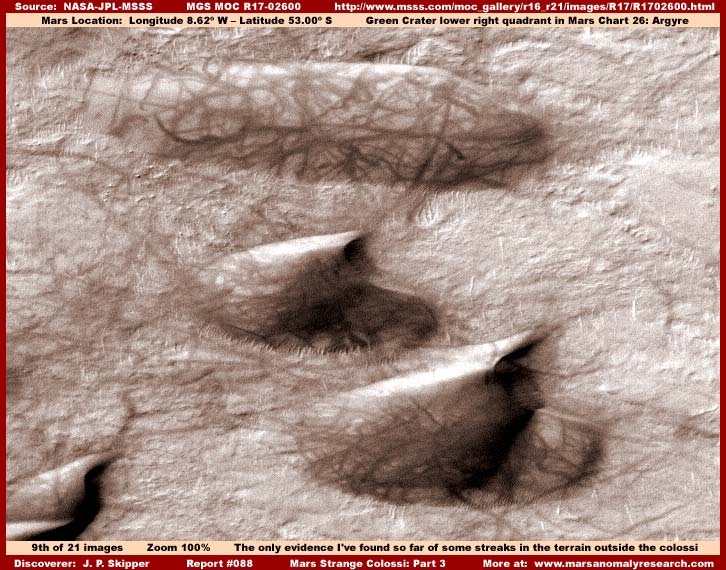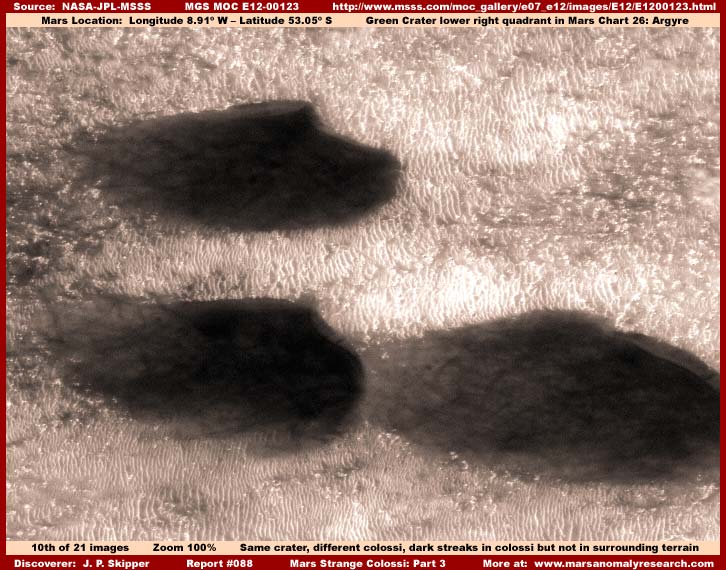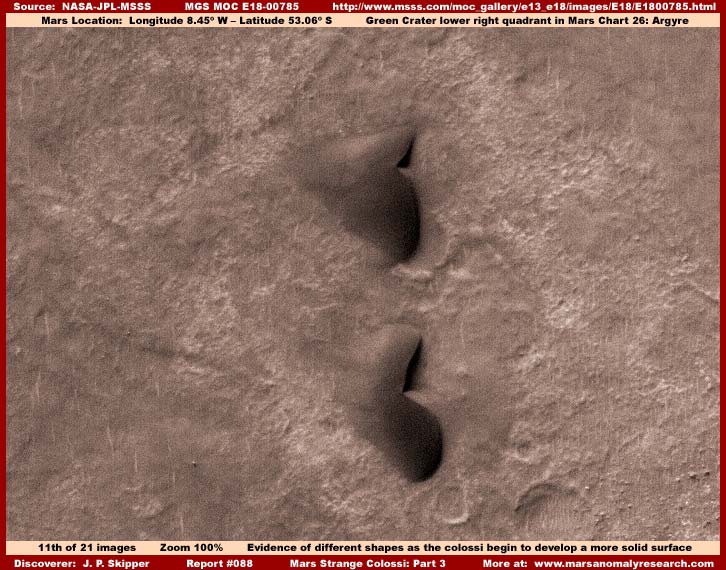
MARS STRANGE COLOSSI
Part 3 of
5
Report #088
July 11, 2005

To be fair, I thought that I would show you the above ninth R17-02600 image taken in 2004 because it does demonstrate dark streaks being in the immediate terrain outside the perimeter of the colossal forms. This evidence is from Green Crater in the Argyre southern region of Mars. Further, please note here that a few of the outside terrain streaks do appear to coincide with some of those within the outer perimeter of the colossi.
Although it is of poor visual quality, there is another R13-02693 image also taken in 2004 showing this same kind of streaks in the terrain evidence. However, this type of evidence of streaks in the surrounding terrain is not typical in my experience and, as you can clearly see, the great bulk of the multitude of streaks within the colossi are much more plentiful than those in the terrain and normally do not coincide with the terrain streaks.
Note here that, except for the top object in the above image, the two other objects below it here share the features of long slopes up from the left to a elevated side on the right. Note to that the objects also share a concave indention on the right side as well as a low flattened area on the lower right. This tends to give them a leading edge front and concave back directional appearance by our Earth human experience and definition. Many times in other strips these objects share such visual shape and directional look similarities. This orientation look contributes to them being officially referred to as "dunes" or "sand dunes" with the implication that this look has been caused by the sculpting of these shapes by prevailing strong winds as a common factor to all the objects.
However, please also note that each of the above objects is like an island alone in its terrain. Note that the surrounding terrain does not demonstrate any evidence of sediment accumulation. Wind strong enough in a prevailing direction to thoroughly sweep the surrounding terrain free of any evidence of accumulated sediment (sand) and sculpt the object's shape would also be strong enough to erode these objects, especially since they are elevated and would catch more of the wind's force. In such circumstances, we would expect to see wind blown sediment accumulations scattered in the terrain downwind on the lee side of these objects. That would logically be on the elevated concave indention side of the object. Yet, there is no such evidence.
That's because, what ever they may have started out to be, these strange objects are now tough, cohesive masses resistant to the Mars natural and geological elemental forces like winds. In other words, what ever they may be, they are not remotely accumulations of loose particulate sediment and therefore not sand "dunes" of any kind. No matter what they may sort of resemble visually in their solid light reflective surface stage of development, these enormous masses are something different that requires thinking outside the box as to what they may really be.

The above 10th image is also from Green Crater and it shows more dark objects with their self contained dark streaks and no other streaks in the surrounding terrain. Very typical but this image was taken roughly two years earlier in 2002 than the ninth image above. Since the ninth image streaks in the surrounding terrain evidence is not typical in my research experience, could this mean that there was a catastrophic failure sometime between 2002 and 2004 of one or more of these gigantic objects in this local Green Crater area and that whatever causes or constitutes these dark streaks within these objects escaped into the surrounding terrain?
Does this in turn mean that the dark streaks represent something individual that operates collectively to form these great individual objects? If so, to what purpose? Is this life? Is it intelligence? Too many questions and not enough answers. It is always the way when one is out on the edge trying to push back ignorance and gain knowledge. Don't worry, knowledge will eventually come if we can keep an open and objective mind and not deny information in favor of familiar preconceived ideas that only serve to block true knowledge.

Now the above 2002 eleventh image from the E18-00785 official science data strip demonstrates what has been officially identified elsewhere in other image strips as "fortune cookie" dunes because of their general shape. Note that here the translucent factor is less than in the ninth and tenth images and now there is more surface texture to the objects and therefore more light reflectivity from their more solid appearing surface. Note the long slope up from the left to the elevated height right side.
On the right, the sharp drop down to the ground and the concave indention on that side is of course what gives these objects their sort of "fortune cookie" dune look. However, once again please note the absence of sediment accumulations in the terrain anywhere around these objects and particularly in the terrain off to the right in what might be assumed to be the downwind or lee side of the objects if strong prevailing winds were actually a factor in creating their shapes. Obviously, no matter what they may appear to look like to the Earth human eye as brief surface glance, closer examination rules out accumulations of sediment.

The above 12th image scene is from the same E18-00785 official science data strip as the above 11th image but taken at a point further down the strip. This scene demonstrates a crater depression on the right, its raised rim on the left, and then normal level terrain beyond that further out to the left. Note that the crater depression shows a lot of evidence of what appears to be dark sediment accumulation in this side of the crater. Note also what appears to be many water erosion gullies in the sediment bank that go down slope from left to right. The erosion gullies indicate this dark mass is likely to be loose particulate sediment.
This in turn leads to the assumption that the rest of the dark mass on the rim of the crater on top of the sediment accumulation and out in the regular ground level terrain further on the left is likewise sediment material because it to is dark and looks so similar in surface texture. In fact, the official description of this strange scene is that of "dunes" appearing to climb out of or into this crater. However, closer examination reveals something else is going on here, in fact two different things.
Further off to the left and above this point (not shown here) are more of these island like dark masses like the ones you see on the left edge of the above 12th image. Note that there are actually subtle difference in surface texture and light reflectivity between the objects I've labeled above in yellow text as Colossi and that I've identified in white text as sediment. Note that the colossi are well defined separate elevated shapes on top of the sediment where as the sediment has no individual shape and merely merges together in a great bank piling up against the inside wall below this crater rim as loose particulate sediment would be expected to do.
It is my contention here, although the visual evidence here certainly isn't conclusive about this, that there are two different things going on here that are not precisely the same, the colossi and true sediment. That in turn brings up the question of whether there is a relationship between the colossi and sediment accumulations beyond the colossi just sort of mimicking the look of sediment? Could these great masses actually be formed from natural sediment accumulations?
Remember that most loose particulate sediment accumulations or dunes we are familiar here on Earth are primarily made up of grains of silica otherwise commonly known to us as sand. Silica is for example the bases for glass and many products here on Earth. We are most familiar with it as a hard surface very rigid tough often transparent material in its cooled state and existing as a flexible material only in a temporary hot and flowing state. Is something or someone on Mars able to manipulate natural accumulations of silica at will to form these great well defined individual colossi masses? Perhaps to fit different purposes including into camouflaged shapes designed to blend in with general area natural features?
Obviously, I don't have the answer to all these questions because the visual evidence is just too limited in this regard to provide it. However, the basic concept I'm trying to get across here is the need to think about this type of evidence independently with a open mind rather than just blindly following the official interpretation geared to a secrecy agenda that spells ignorance and no real insight for the rest of us. In other words, try to think for yourself and objectively outside the box.
DOCUMENTATION
http://www.msss.com/moc_gallery/r16_r21/images/R17/R1702600.html: This link will take you to the official MGS MOC R17-02600 science data strip that the evidence in my above 9th image was drawn from.
http://www.msss.com/moc_gallery/r10_r15/images/R13/R1302693.html: This link will take you to the official MGS MOC R13-02693 visually poor quality science data strip with evidence very similar to that in the above R17-02600 strip but which I did not drawn any of my imaging from. Like R17-02600, it to shows streaks in the terrain as well as within the colossi, just not nearly as clear.
http://www.msss.com/moc_gallery/e07_e12/images/E12/E1200123.html: This link will take you to the official MGS MOC E12-00123 science data strip that my above 10th image was drawn from.
http://www.msss.com/moc_gallery/e13_e18/images/E18/E1800785.html: This link will take you to the official MGS MOC E18-00785 science data strip that my above 11th and 12th image evidence was drawn from.
, Investigator
Contact the:
![]()